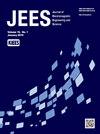Magnetic Field Analysis of Hollow Halbach Long Stator Permanent Magnet Synchronous Linear Motor for Suspension Permanent Magnet Maglev Train
IF 1.7
3区 工程技术
Q3 ENGINEERING, ELECTRICAL & ELECTRONIC
Journal of electromagnetic engineering and science
Pub Date : 2023-06-19
DOI:10.26866/jees.2023.4.r.174
引用次数: 0
Abstract
In suspended permanent magnet maglev trains, the magnetic field generated by hollow-type permanent magnet synchronous linear motors is one of the main sources of low-frequency electromagnetic fields. To investigate the magnetic field generated by the linear motor in the train, this paper first establishes the 2D and 3D models of the linear motor using ANSYS EM software. Then, the electromagnetic simulation of the magnetic field of the linear motor is performed under conditions of no load and full load. Next, the magnetic field of the motor is measured using a six-channel high-precision magnetic field test system, and the simulation and measurement results are compared. The result analysis indicates that the energy distribution of the electromagnetic field generated by the linear motor is uniform and that the magnetic induction intensity falls within the range of 0 to 1.1 T. Meanwhile, the linear motor can form a closed loop with a small electromagnetic field energy leakage. Combined with its installation structure, the radiation to the surrounding environment is weak, and the interference with the normal operation of the train control communication equipment is minimal. This study lays a foundation for analyzing electromagnetic distribution on the surface of the suspended permanent magnet maglev train. It also provides a basis for formulating various electromagnetic radiation protection measures and provides theoretical support for developing suspended permanent magnet maglev trains.悬浮式永磁磁悬浮列车用空心Halbach长定子永磁同步直线电机磁场分析
在悬浮式永磁磁悬浮列车中,空心型永磁同步直线电机产生的磁场是低频电磁场的主要来源之一。为了研究直线电机在列车中产生的磁场,本文首先利用ANSYS EM软件建立了直线电机的二维和三维模型。然后,对直线电机在空载和满载情况下的磁场进行了电磁仿真。其次,利用六通道高精度磁场测试系统对电机的磁场进行测量,并将仿真结果与测量结果进行比较。结果分析表明,直线电机产生的电磁场能量分布均匀,磁感应强度在0 ~ 1.1 t范围内,同时直线电机能形成闭环,电磁场能量泄漏小。结合其安装结构,对周围环境的辐射较弱,对列控通信设备正常运行的干扰最小。该研究为分析悬浮式永磁磁悬浮列车表面电磁分布奠定了基础。为制定各种电磁辐射防护措施提供依据,为发展悬挂式永磁磁悬浮列车提供理论支持。
本文章由计算机程序翻译,如有差异,请以英文原文为准。
求助全文
约1分钟内获得全文
求助全文
来源期刊

Journal of electromagnetic engineering and science
ENGINEERING, ELECTRICAL & ELECTRONIC-
CiteScore
2.90
自引率
17.40%
发文量
82
审稿时长
10 weeks
期刊介绍:
The Journal of Electromagnetic Engineering and Science (JEES) is an official English-language journal of the Korean Institute of Electromagnetic and Science (KIEES). This journal was launched in 2001 and has been published quarterly since 2003. It is currently registered with the National Research Foundation of Korea and also indexed in Scopus, CrossRef and EBSCO, DOI/Crossref, Google Scholar and Web of Science Core Collection as Emerging Sources Citation Index(ESCI) Journal. The objective of JEES is to publish academic as well as industrial research results and discoveries in electromagnetic engineering and science. The particular scope of the journal includes electromagnetic field theory and its applications: High frequency components, circuits, and systems, Antennas, smart phones, and radars, Electromagnetic wave environments, Relevant industrial developments.
 求助内容:
求助内容: 应助结果提醒方式:
应助结果提醒方式:


